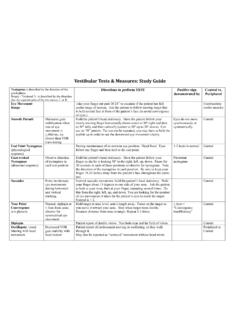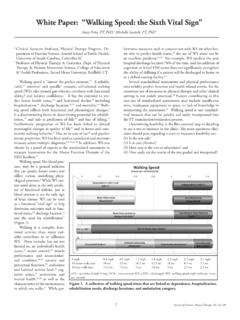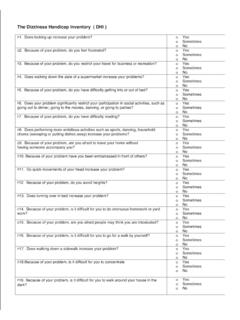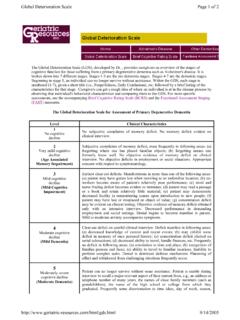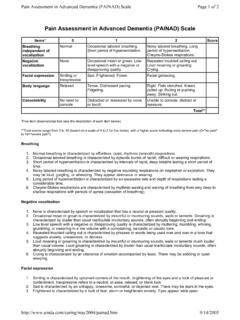Transcription of Scoring Form for Fullerton Advanced Balance (FAB) Scale
1 California State University, Fullerton Center for Successful Aging Scoring form for Fullerton Advanced Balance (FAB) Scale Name: Date of Test: _____ 1. Stand with feet together and eyes closed ( ) 0 Unable to obtain the correct standing position independently ( ) 1 Able to obtain the correct standing position independently but unable to maintain the position or keep the eyes closed for more than 10 seconds ( ) 2 Able to maintain the correct standing position with eyes closed for more than 10 seconds but less than 30 seconds ( ) 3 Able to maintain the correct standing position with eyes closed for 30 seconds but requires close supervision ( ) 4 Able to maintain the correct standing position safely with eyes closed for 30 seconds 2. Reach forward to retrieve an object (pencil) held at shoulder height with outstretched arm ( ) 0 Unable to reach the pencil without taking more than two steps ( ) 1 Able to reach the pencil but needs to take two steps ( ) 2 Able to reach the pencil but needs to take one step ( ) 3 Can reach the pencil without moving the feet but requires supervision ( ) 4 Can reach the pencil safely and independently without moving the feet 3.
2 Turn 360 degrees in right and left directions ( ) 0 Needs manual assistance while turning ( ) 1 Needs close supervision or verbal cueing while turning ( ) 2 Able to turn 360 degrees but takes more than four steps in both directions ( ) 3 Able to turn 360 degrees but unable to complete in four steps or fewer in one direction ( ) 4 Able to turn 360 degrees safely taking four steps or fewer in both directions *4. Step up onto and over a 6-inch bench ( ) 0 Unable to step up onto the bench without loss of Balance or manual assistance ( ) 1 Able to step up onto the bench with leading leg, but trailing leg contacts the bench or leg swings around the bench during the swing-through phase in both directions ( ) 2 Able to step up onto the bench with leading leg, but trailing leg contacts the bench or swings around the bench during the swing-through phase in one direction ( ) 3 Able to correctly complete the step up and over in both directions but requires close supervision in one or both directions ( ) 4 Able to correctly complete the step up and over in both directions safely and indepen- dently Revised Sept 2008 (DR) California State University, Fullerton Center for Successful Aging *5.
3 Tandem walk ( ) 0 Unable to complete 10 steps independently ( ) 1 Able to complete the 10 steps with more than five interruptions ( ) 2 Able to complete the 10 steps with three to five interruptions ( ) 3 Able to complete the 10 steps with one to two interruptions ( ) 4 Able to complete the 10 steps independently and with no interruptions *6. Stand on one leg ( ) 0 Unable to try or needs assistance to prevent falling ( ) 1 Able to lift leg independently but unable to maintain position for more than 5 seconds ( ) 2 Able to lift leg independently and maintain position for more than 5 but less than 12 seconds ( ) 3 Able to lift leg independently and maintain position for 12 or more seconds but less than 20 seconds ( ) 4 Able to lift leg independently and maintain position for the full 20 seconds *7. Stand on foam with eyes closed ( ) 0 Unable to step onto foam or maintain standing position independently with eyes open ( ) 1 Able to step onto foam independently and maintain standing position but unable or unwilling to close eyes ( ) 2 Able to step onto foam independently and maintain standing position with eyes closed for 10 seconds or less ( ) 3 Able to step onto foam independently and maintain standing position with eyes closed for more than 10 seconds but less than 20 seconds ( ) 4 Able to step onto foam independently and maintain standing position with eyes closed for 20 seconds Do not introduce test item #8 if test item #4 was not performed safely and/or it is contraindicated to perform this test item (review test administration instructions for contraindications).
4 Score a zero and move to next test item. 8. Two-footed jump ( ) 0 Unwilling or unable to attempt or attempts to initiate two-footed jump, but one or both feet do not leave the floor ( ) 1 Able to initiate two-footed jump, but one foot either leaves the floor or lands before the other ( ) 2 Able to perform two-footed jump, but unable to jump farther than the length of their own feet ( ) 3 Able to perform two-footed jump and achieve a distance greater than the length of their own feet ( ) 4 Able to perform two-footed jump and achieve a distance greater than twice the length of their own feet Revised Sept 2008 (DR) California State University, Fullerton Center for Successful Aging 9. Walk with head turns ( ) 0 Unable to walk 10 steps independently while maintaining 30o head turns at an established pace ( ) 1 Able to walk 10 steps independently but unable to complete required number of 30o head turns at an established pace ( ) 2 Able to walk 10 steps but veers from a straight line while performing 30o head turns at an established pace ( ) 3 Able to walk 10 steps in a straight line while performing 30o head turns at an established pace but head turns less than 30o in one or both directions ( ) 4 Able to walk 10 steps in a straight line while performing required number of 30o head turns at established pace 10.
5 Reactive postural control ( ) 0 Unable to maintain upright Balance ; no observable attempt to step; requires manual assistance to restore Balance ( ) 1 Unable to maintain upright Balance ; takes two or more steps and requires manual assistance to restore Balance ( ) 2 Unable to maintain upright Balance ; takes more than two steps but is able to restore Balance independently ( ) 3 Unable to maintain upright Balance ; takes two steps but is able to restore Balance independently ( ) 4 Unable to maintain upright Balance but able to restore Balance independently with only one step TOTAL: 40 points Evaluating Risk for Falls: Long form Fullerton Advanced Balance (FAB) Scale Cut-Off Score: 25/40 points Short- form Fullerton Advanced Balance (FAB) Scale Cut-Off Score: 9/16 points Revised Sept 2008 (DR)

